A mapping of products and material used within live role-play
2 Products and material
During the past few years, the market for role-play equipment has seen a rapid growth in Denmark.
The breakthrough for this group of products followed in the wake of the film-trilogy “Lord of the Rings” which was showing at the movies in December 2001, 2002 and 2003.
The products and material used by role-players partly overlap those of theatres and movies. Costumes, make-up and various props are used.
In the past, it was popular among children to produce weapons made of bamboo sticks and foam plastic wrapped with duct tape. However, concurrent with this hobby becoming increasing popular, a whole market of ready-made products has emerged. Parallel to this, a new form of home production has emerged, seeking to imitate the great-looking ready-made products.
There are 3 way of potentially being exposed to chemical substances:
- During home production of equipment
- Through use of ready-made and home-produced products
- Through maintenance of ready-made and home-produced products
Below is an illustration of the access to possible problems:
Figure 2:

Home production of peasant’s coats, amours and other equipment also takes place to a certain extent, but this report focuses on materials used in the production of weapons.
The mapping has been carried out through visits to distributors and producers of role-play equipment.
They have all been asked to provide estimated figures of the sale of various products based on their own experience and knowledge of the market in Denmark. The results are summarised below.
Year by year, the sales of role-play products have doubled, but it is estimated by the actors in the field that sales are beginning to level out. Several actors believe that sales in 2006 will double that of 2005.
Interviews with the actors were conducted through April-May 2006.
2.1 Ready-made products
Ready-made role-play products are distributed through specialist role-play shops in the cities, role-play departments in e.g. toy stores and book stores, and through cheap offers in supermarket chains.
Role-play stores primarily distribute equipment produced in Denmark and also some produced in Germany. The supermarkets import equipment that is produced in e.g. China. A number of special products as e.g. skin glue and latex toner are either produces in Denmark or imported, whereas others, as e.g. artificial blood, are, without exception, imported.
Some typical product areas, which are also used for live role-playing, are described in a previous corresponding report. This covers make-up, which is therefore not described in the present survey.
The Figure below indicates and estimated annual sale (in 2005) of the various product areas. Furthermore, it is indicated with a þ whether an evaluation of the chemical content will be described later in the report.
The photos are randomly selected examples of the illustrated product group.
Figure 3: An overview of products and sale in 2006
| Random examples of the products | Sales | Potential problem areas |
 |
Latex weapon Estimated sales are 30.000 weapons, comprising swords, bludgeons and other striking weapon These weapons are build around a core of glass fibre, foam plastic, latex, paint and varnish. |
It is estimated that use of ready-made weapons does not cause any problems to the health However, weapons get worn by use and it is common to maintain these by adding silicone – see under silicone in the Figure |
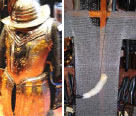 |
Metal armour 500-600 metal armours are sold per year. Normally, single parts are sold, such as arm or shin guards. Sales of these are an estimated 10.000. |
It is estimated that use of metal armours does not cause any problems to health other than allergies. Depending on the type of metal, there is a risk of liberation of nickel, which may cause allergy. Also, various products are used for maintenance. These have not been tested. |
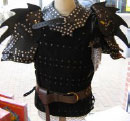 |
Leather armours Annual sales of leather armours are estimated to be 2.500. Primarily, single parts are sold. Sales of these are an estimated 10.000 |
It is estimated that the use of leather armours worn on clothes does not cause any problems to the health other than allergies. Metal rivets may contain nickel, which, if liberated, may cause allergy. Also, various products are used for maintenance. These have not been tested. |
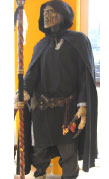 |
Peasant’s coats and capes Annual sales are 3-4000. |
It is estimated that the use of these garments does not cause any problems to the health |
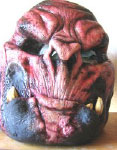 |
Latex masks Annual sales are approx.1.000 rubber masks and a corresponding number of rubber helmets. The masks are made of latex, which has been painted |
Latex can liberate substances, which may be absorbed through the skin or inhaled. There is a risk of acquiring latex allergy (according to the Danish National Board of Health, approx 1% of the population has latex allergy) Will be evaluated later þ |
 |
Latex ears Annual sales are approx. 15.000 artificial latex ears. The ears are glued to the skin. Various kinds of glue are used. The glue is either sold with the ears or separately |
There is a risk of acquiring latex allergy – look above under latex masks for details. But besides from that, it is presumed that the use of latex ears does not cause any problems to the health. The kit glued may possibly contain suspicious substances. Will be evaluated later þ |
 |
Wounds, scars and noses Other latex products are sold, such as wounds, scars and noses. These are glued to the body. Annual sales are 2-3000. |
There is a risk of acquiring latex allergy- look above under latex masks for details. Besides from this, it is presumed that the use of latex ears does not cause any problems to the health. Glue will be examined laterþ. |
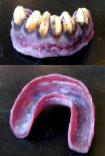 |
Artificial teeth Annual sales are 1000-1500 sets of art artificial teeth in the form of rubber gums. Latex teeth are coloured |
During use, substances from the colour and latex may be liberated to the skin or orally through the saliva. There is a risk of acquiring latex allergy- look above under latex masks for details. |
 |
Vampire’s teeth A small amount is sold annually (approx 300) which are glued to the teeth with the accompanying glue paste |
Glue paste See comments under latex ears Glue will be examined laterþ. |
 |
Wine skins Various accessories are on the market. The most popular one is the wine skin. Annual sales are approx. 3000-4000. The number may be larger, since this is a very popular item which is sold more widely than the other items. A wine skin consists of a container covered by skin |
Potential health risks depending of what material the container is made of. One distributor informed that the membrane is made of latex To be examined laterþ. |
 |
Skin Glue Various types of glue are sold for attaching artificial ears, noses, wounds and scars. Sales are estimated to be around 7-10.000 units |
Skin glue is sold in solvent-based and water-based varieties. The content of skin glue will be examined later þ |
 |
Glue remover For removing glue after use. It is estimated that max sales are 1000 units. |
Normally, distributor advise against the use of skin glue, since allergic reaction after use is not uncommon The content of glue remover will be examined later þ |
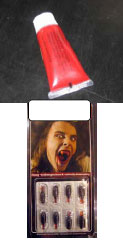 |
Artificial blood Various types of artificial blood product are sold. These are either for application to the skin or pills to be chewed. It is estimated that max. sales are 500 units. |
The content of the blood products will be examined later þ |
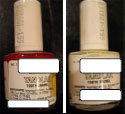 |
Tooth varnish A very small amount of tooth varnish is sold |
The content of tooth varnish will be examined later þ |
2.2 Products for home production and maintenance
Home production comprises both activities at home and in youth centres and SFO’s, where it has become a popular educational activity to produce weapons and other equipment for role playing.
The materials for this are bought from many different sources, partly from specialisy role-play shops and DIY centres and partly from special suppliers. The products are often commercialised for other purposes.
Actors estimate that weapon production is an activity that takes place in every third SFO and in almost all youth centres. A survey based on questionnaires, which is part of this project, has revealed that at least every 5 institution conduct this activity. A random check on those who didn’t return the questionnaire revealed that possibly, the activity takes place in every second institution.
Earlier on, production of duct tape weapons was popular, but in the wake of the film-trilogy “Lord of the Rings” which had its opening in December 2001, a rapidly growing market has emerged with e.g. Danish produces realistic latex weapons. This meant that primitive duct tape weapons were no longer welcome in role-play circled, and therefore, the hobby of home production of latex weapons spread fast. It has become a very popular activity in institutions, where a person skilled within role playing and latex weapons is often in charge of the area. Besides from weapons such as swords, bludgeons, axes etc, other latex products are also produces, such as ears and teeth, however to a small extent.
Below is a description of the production of a sword, but the process is almost the same for all latex products. Smaller item, such as ears, are cast in a mould into which latex is poured in several turns.
2.2.1 How are home-made latex weapon produced?
There are various methods of production. The following description is made on the basis of visits to clubs, interviews with children and studying of various manuals that are displayed on e.g. the role-play societies’ homepages.
The following materials are used:
- Latex (natural latex or the like)
- Glass fibre, bamboo and tubes
- Sleeping pads or other foam materials, or possibly pipe isolation
- Possibly fabric or sheeting in neutral colours
- Colour pigment for latex and/or spray paint
- Double-sided adhesive tape and/or contact glue
Figure 4: Drawing of materials for a sword. Source: www.live-rollespil.dk.

Side pieces, middle piece, minimum 10 cm, air holes, air space for the core, ca. 1 cm double-sided adhesive tape
Summary of the method of production
- The blade is cut out from a sleeping pad. The middle piece is cut out leaving room for the core. This is done by cutting an air space. In order to make the weapon soft, the middle piece should also have air space.
- The core consists of glass-fibre stick or of a tube with a bamboo stick inside. Sticks or pipes are cut to fit the length of the air space and the shaft together.
- The core is attached to the sleeping pad, either with double-sides adhesive tape or contact glue. The shaft is attached in the same way. The shaft is often made of a piece of pipe isolation or sleeping pad cut to fit.
- Then the fluid latex is applied. The latex is added a latex toner before it is applied to the weapon.
Latex may be applied in different ways. Here are a few examples:
- By painting the latex on the foam plastic with a brush
- By dipping your fingers into latex and apply it with your fingers
- By dipping the weapon into a vat of latex
- By dipping fabric into latex and smooth it on the weapon
- Latex is applied in many layers, and the weapon needs to dry between each application. This is done by hang drying it. The process is identical to that of dipping candles. A hair drier or ventilation may be used in order to speed up the process.
- The shaft may be covered in leather, and the weapon may be decorated with stones, lace, or leather. Some also suggest that parts of the weapon are spray painted.
- Latex is finished with silicone, which is sprayed on when the weapon is ready and after each use. Or the weapon may be finished with talcum powder.
The above is a very overall description, and there are several variants: Some make patterns in the sleeping pads with a copper bit, some grind the sleeping pad in order to remove all impurities, and others heat the sleeping pad in order to melt the layers and thus remove all transitions and so forth.
During the study, we came across home pages that recommended the use of substances that are illegal in Denmark. For instance, the use of isoflex as a finisher in order to obtain a harder and more durable surface than with silicone. Isoflex is very toxic and may not be sold in Denmark.
“Your weapon may also be protected with a latex varnish. It is called isoflex and is very expensive, but you need only a small amount for each weapon. It may be imported from USA where it is produces, or try buying it from on of the latex-weapon producers.
The above statement was found on a home-page that apparently is a few years out dated. It is illegal to buy toxic or very toxic substances from the internet.
2.2.2 Applied materials
In order to uncover what materials are being used when producing weapons at home, interviews with the LLR (the National Association of Live Role-player) have been conducted and literature and homepages guides to the production of weapons and other equipment have been studied.
The figure below is an overview of the most typical products used in preparing role-play equipment. The figure displays types of products as well as tangible products that we have come across. Materials for home-made role-play weapons are not connected to a specific commercialised product group. You may find some products in specialist shops, but the products may also be procured through other channels.
Therefore, it is generally difficult to provide an educated estimate of the consumption, since these materials may be procured from specialist shops and a range of other shops, e.g. DIY centres, supermarkets, paint dealers, hardware dealers and shops with home equipment. Here, the products are not specifically sold for role-play purposes, and the dealers have no knowledge of the share that is sold for this purpose.
In the figure below, it is indicated with a þ whether an evaluation of the chemical content will be described later in the report. For a number of products, it is not possible to estimate the sales to role-play purposes, since these products are sold for many other purposes, as mentioned above.
Figure 5: A summary of products used in the production of weapons
| Random examples of the products | Description | Potential problem areas |
 |
Glass-fibre stick A round glass fibre stick is used as the core in swords and another long weapon. They are sold in specialist role-play shops as well as in DIY centres. Glass-fibre sticks have replaced the bamboo stick as the core of the weapon, and the main part of home-made weapon have a glass-fibre core |
When the glass-fibre stick is sawed to adjust the length, glass-fibre dust is released to the air. The health aspect of this has not been further studied, since it is estimated not to have any consequences to the health of the child. Furthermore, the release of dust may be prevented by pouring water during the sawing |
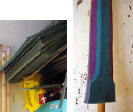 |
Foam plastic. Foam plastic is used to shape the weapon. Sleeping pads are typically used, which are cut and attached to the glass-fibre stick with glue and the wood handle. Various types of foam plastic is used |
After being cut, the foam plastic is possibly grinded in, which releases dust to the air. Possible removal of foam dust with heat (ironing) which releases vapour to the air. A possible decoration of the foam with a copper bit, which also release vapour to the air Will be evaluated later þ. |
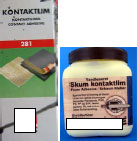 |
Contact glue Normally, several layers of foam plastic are used, which are glued together. Here, contact glue is typically used, which may be water-based or solvent-based. Alternatively, double-sided adhesive tape may be used |
Glues base don solvents contain unhealthy substances. The content of some of these products have been mapped. Will be evaluated later þ. Tape has not been examined, since it is estimated not to have any consequences to peoples health |
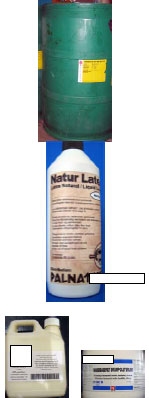 |
Liquid latex The basic form of the weapon is covered in liquid latex (natural latex). Almost everybody use the same basic product from Thailand, which is then decanted to own products by the dealers. Various variants of natural latex are sold with a varying content of ammonia. It is estimated that annual sales are around 3000 Litres. |
Latex contains ammonia and possibly nitrosamines and VOC, which are released during the production of the weapons. Will be evaluated later þ. Some children may have latex allergy (according to the Danish National Board of Health, approx 1% of the population has latex allergy) |
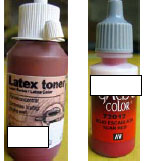 |
Latex toner Latex toner is added to latex to provide a basis colour. Toners from specialist role-play shops as well as from traditional paint dealers are used. Apart from the marketed latex toners, colours for painting little role-play figures are also used. The sales are estimated very differently by the actors and vary from 1000 to 12000 units, which again is between 50 and 600 litres. |
A number of the latex toners will have the content of substances examined þ. |
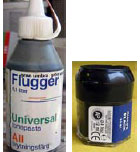 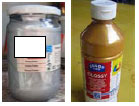 |
Colour The almost ready weapon is possibly painted to give it an extra good look. Various colours are used for this, possibly spray paint |
A few colours will have the content of substances examined. þ. . |
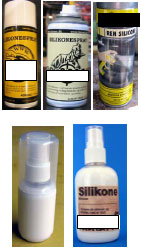 |
Silicone The weapon is finished with a silicone layer which for one gives the weapon a shine surface and also protects the latex and colours during use. The weapon, also ready-bought, is typically maintained by applying silicone after each use. There are 3 main types: Spray cans sold for role-play purposes, spray cans marketed for maintenance of cars, and containers with a mechanical pump solution. Silicone is typically sold together with a ready weapon. Besides from this, it is used in home production. Estimated sales are around 30.000 units. |
The content of substances of the various silicone sprays will be examined laterþ. |
Version 1.0 August 2007, © Danish Environmental Protection Agency